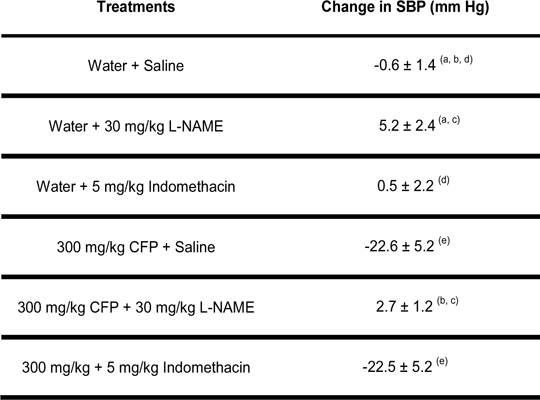Print version
Search Pub Med
Nitric oxide mediates the antihypertensive and vascular relaxing effects of a soluble cocoa fiber product in spontaneously hypertensive rats Introduction and aim. A cocoa fiber product (CFP) obtained from cocoa husks via a patented enzymatic process was characterized as a soluble fiber with 22.4 ± 1.4 mg/g dry matter polyphenol content. In a previous study, we demonstrated the antihypertensive properties of CFP in spontaneously hypertensive rats (SHR). The aim of this research was to elucidate the involvement of endothelial relaxing factors, and in particular the involvement of nitric oxide, in the antihypertensive and vascular relaxing effects of CFP in these animals. Methods. We carried out in vitro and in vivo experiments. In the in vitro experiments, CFP (10-6 mg/ml – 10-3 mg/ml) was administered to different 10-5 M methoxamine-precontracted aorta ring preparations [intact, endothelium-denuded, intact incubated with 10-4 M NW-nitro-L-arginine methyl ester (L-NAME) and intact incubated with 10-5 M indomethacin] from untreated 24 - 28 week-old male SHR. For the in vivo experiments, a total of thirty 17–20 week-old male SHR were used. They were divided into two groups of fifteen animals, that were respectively administered by gastric intubation 1 ml distilled water or 300 mg/kg CFP dissolved in the same volume of distilled water. Four hours after these administrations, five of the animals in each group were intraperitoneally administered 1 ml saline. The remaining rats in both groups were divided into another two groups of five animals that were respectively administered, by the same procedure, 30 mg/kg L-NAME or 5 mg/kg indomethacin, both dissolved in 1 ml of saline. Systolic blood pressure (SBP) was recorded in the different rats by the tail cuff method before the initial oral administration and also 6 h after. Results. CFP relaxed the intact aorta ring preparations in a dose dependent manner. This effect was almost abolished in the endothelium-denuded preparations and partially blocked in the intact rings treated with L-NAME, but it was not significantly modified by indomethacin (see table 1). In addition, CFP caused a significant decrease in SBP. L-NAME caused a slight increase in SBP in the rats, and the effect of CFP was not observed in the SHR that were treated with L-NAME. Nevertheless, indomethacin treatment did not modify SBP in the SHR and this drug failed to modify the antihypertensive effect of CFP in these animals (see table 2). Table 1. Release (%) caused by CFP in different aorta rings. Values represent mean ± SEM for at least 6 preparations obtained from different animals.
The maximum released was compared and similar letters means no statistical differences (P> 0.05). P estimated by one-way ANOVA.
Table 2. Changes in systolic blood pressure caused in spontaneously hypertensive rats by different treatments. Values represent mean ± SEM for at least 5 animals. 
Similar letters means no statistical differences (P> 0.05). P estimated by one-way ANOVA. Conclusions. This study demonstrates the involvement of nitric oxide in the antihypertensive and aorta relaxing effects of CFP in SHR. Supported by Natracéutical Group (206/2006 UCM Project).
|


